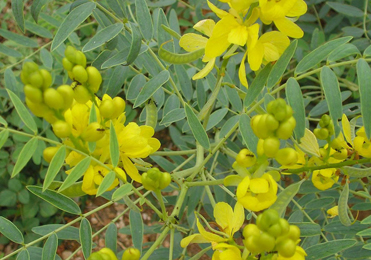
Overview
- Latin name – Cassia angustifolia
- English name – Senn
- Indian name – Sanay, Swarna Patri
Senna is one of the most often used herb in Ayurveda- traditional Indian system of health. It has a reputation as a powerful purging herb
Plant Description
Senna is a small, perennial, branched, drought resistant undershrub growing to a height of 60 – 75 cm.
Chemical Constituents
The leaves and green, immature pods contain glycosides like sennocides A and B, which are extensively used as a laxative particularly for habitual constipation.
Parts Used
Leaves.
Benefits of Senna
- The leaf power of Senna is used in acute and chronic constipation. Even 1 dose reduces the constipation quickly.
- The decoction of powder of Senna can also be taken before bed time.
- Senna is a very strong laxative herb which may cause griping if used without other herbs. It is wise to use it in combination with warming, stimulating and antispasmodic herbs such as Ginger. Other appropriate herbs might include Cloves, Fennel, Cinnamon, and Coriander. It is important to realize that cathartic laxatives such as Senna should not be overused because this may lead to laxative dependency. Dietary changes, increased water intake, demulcent and bulk laxative herbs, and relaxation techniques should be explored before resorting to cathartic laxatives. In combination with other anthelminthic herbs it is used to expel intestinal worms
- The dried leaves and fruits of Cassia acutifolia and C. angustifolia. The principal active constituents of senna are dianthrone glycosides whose aglycone is Rhein. Rhein-induced laxative effects occur through two distinct mechanisms: an increase in intestinal fluid transport and an increase in intestinal motility. Senna taken in recommended doses may lead to abdominal complaints whilst prolonged use causes melanosis coli.
Dosage
Senna Powder : 3-6 grams per day.
To buy Senna Leaves Powder, please visit store.planetayurveda.com/senna-leaves-powder.html
